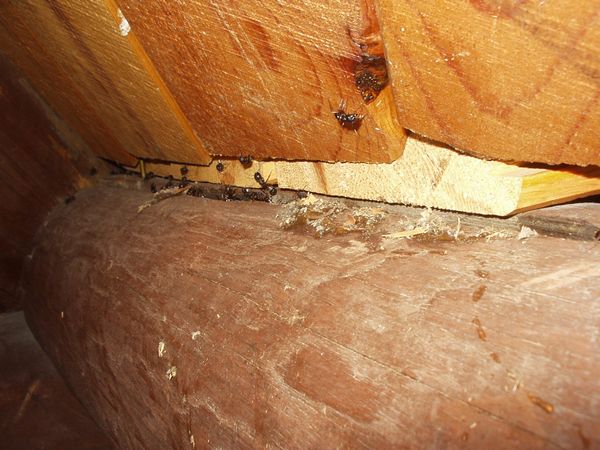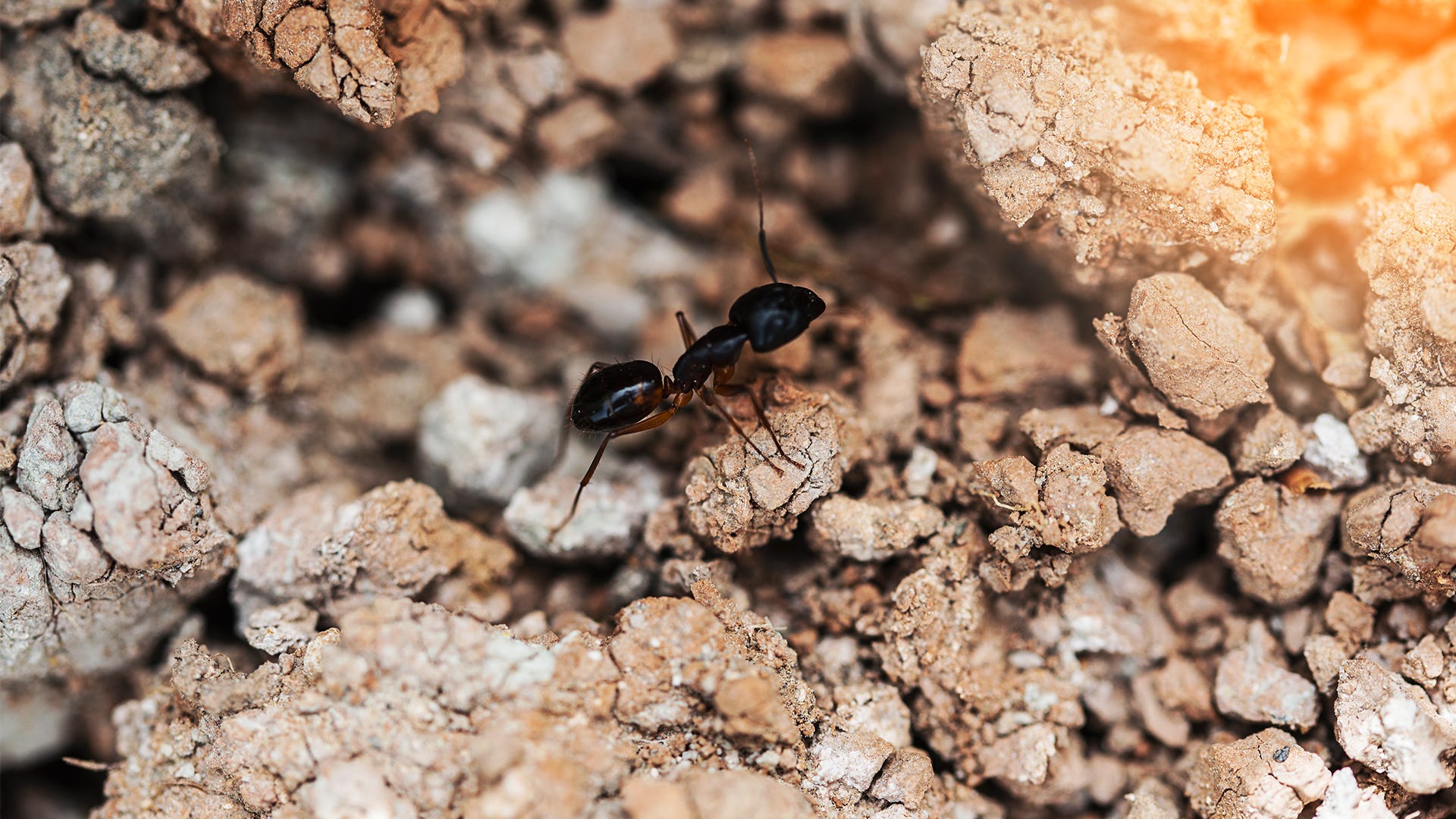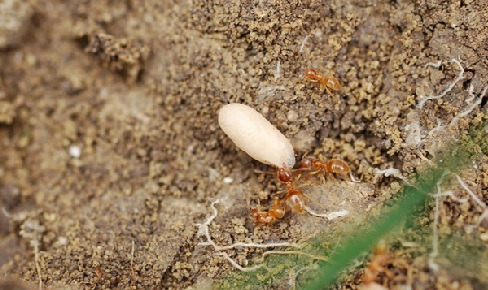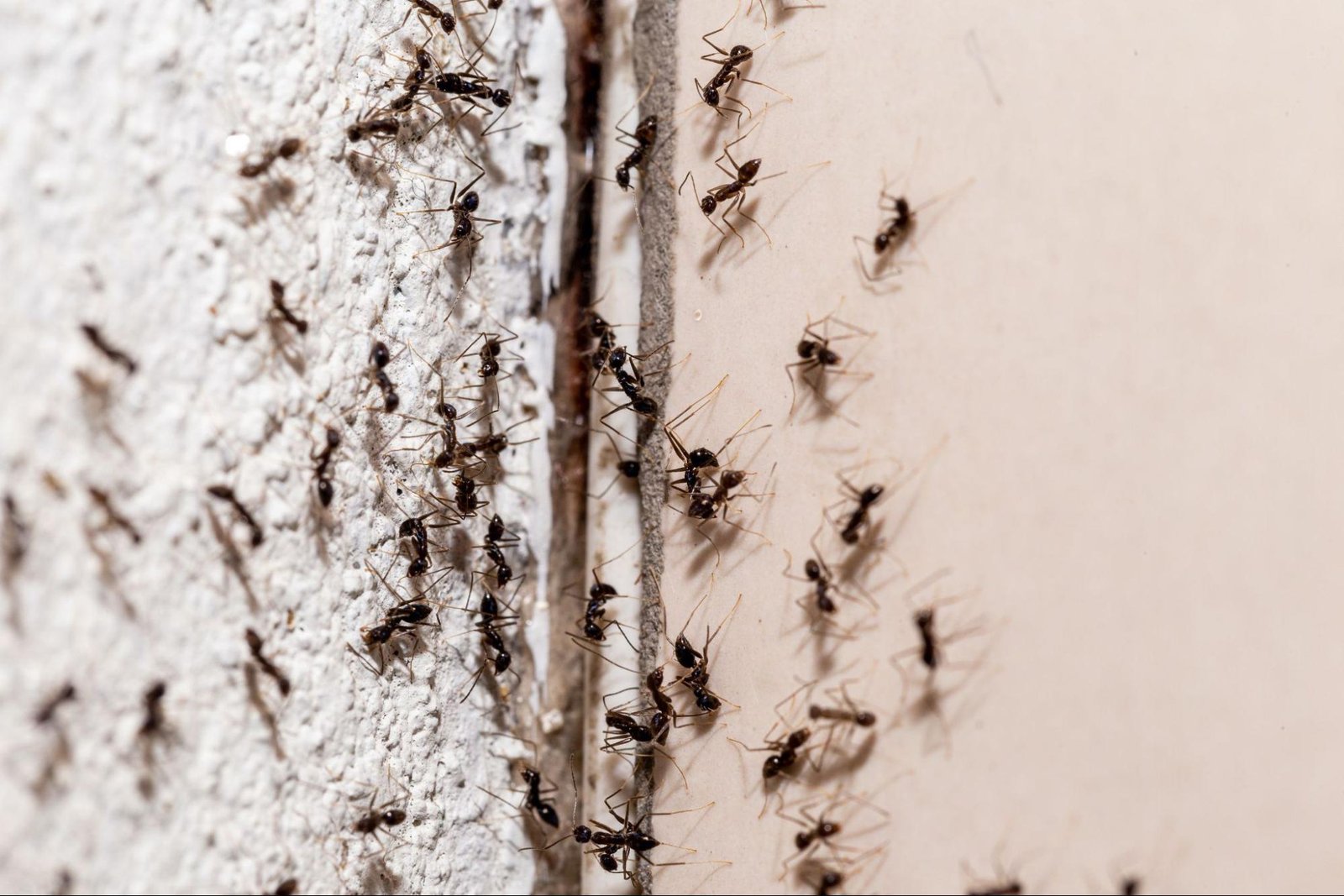Signs of ants nesting inside your home include visible ant pathways and small piles of dirt or sawdust. You might also notice structural wood damage or a musty odor indicating a larger infestation.
Discovering ants in your home can be worrying, especially when they’re nesting indoors. Ant infestations can occur for various reasons, such as access to food and water or shelter from outdoor conditions. Homeowners should remain vigilant for subtle signs of nests, which could hide inside walls, under floors, or even in seemingly undisturbed areas.
Identifying these nests early is crucial to prevent structural damage and ensure quick removal. Stay alert for unusual ant activity, which is often the first red flag of an indoor colony taking root. Keeping your living spaces clean and addressing spills immediately can discourage ants from settling in but seeking professional pest control might be necessary if you suspect a serious infestation.

Credit: eastsideexterminators.com
Signs Of Ant Colonies In Your Home
Discovering ants in your home can be unsettling. Knowing the signs of ant colonies ensures you can take quick action. Ants are social insects. This means that where one ant goes, others often follow. Spotting these signs early can save your home from a full-blown infestation. Keep an eye out for these tell-tale indicators.
Visible Ant Trails
One clear sign of an ant problem is seeing ant trails. These are lines of ants marching to and from a food source. Look for them in kitchen areas or where food crumbs are common. Ants leave an invisible pheromone trail to guide other ants to the food source.
- Kitchen counters
- Pantries
- Along walls
- Near pet food bowls
Piles Of Soil Or Dirt Indoors
Ant nests can result in small piles of soil or dirt inside your home. These piles are often located near baseboards, doorways, or other entry points to your home.
| Location | Possible Signs |
|---|---|
| Baseboards | Loose dirt or sand particles |
| Doorways | Small piles of excavated earth |
| Windowsills | Soil buildup indicating an entry point |
Witnessing either of these signs could point to ants setting up their colony within your walls. Prompt action is key. Contact a professional for an effective solution.
Common Areas For Ant Nesting
Discovering ants in your home is never a welcome surprise. These savvy insects often build nests in areas that provide ample food sources and shelter. To safeguard your dwelling, it’s crucial to recognize the common locales ants may establish their colonies. Below are the frequent hotspots within your house where ant nesting is prevalent.
Kitchens And Food Storage Areas
Kitchens represent a paradise for ant colonies due to easy access to food and water. It’s essential to inspect the following kitchen-specific zones for evidence of ant nesting:
- Cabinets and pantries: Ants often march towards sugary or greasy food remains in storage areas.
- Under appliances: Crumbs and spills underneath microwaves or toasters offer perfect feeding grounds for ants.
- Sinks and plumbing fixtures: A consistent water supply from leaks or drips attracts ant populations.
Regularly clean these areas to disrupt potential ant nesting sites.
Walls And Hidden Structures
Ants favor secluded spaces within your home for their nests. They commonly infiltrate wall voids or other inconspicuous structures. Look out for the signs below:
- Electrical outlets and sockets: Tiny openings around these fixtures provide easy access for ants.
- Wall cracks and crevices: Even the smallest gaps can become a gateway for ants into your home.
- Behind baseboards and window frames: These areas often harbor undisturbed environments ideal for ant nests.
Detecting fine piles of dirt or sawdust nearby could indicate an ant nest hidden within these structures.
Behavioral Indicators Of Ant Infestation
Discovering if ants have made themselves at home can be tricky. But watch out for tell-tale actions that signal an infestation. Your house might just be their new colony!
Agitated Pet Behavior
Pets often sense things before humans do. If your cat or dog seems more anxious or paces more than usual, take note. They might be detecting ants. These tiny invaders can irritate pets, especially when nesting nearby. Watch your furry friends closely; they could lead you to hidden ant nests.
Frequent Sightings Of Scout Ants
Ants send scouts to find food and shelter. Spotting these lone ants can signal a nearby nest. Scouts leave scent trails for others to follow. If you see ants walking in a line, it’s time to act. They’re telling the rest of the colony that your home has resources.
- Increasing ant numbers show nesting activity.
- A single ant may look harmless, but it’s a sign.
- Scent trails can lead to the main infestation.
Ants speak through behavior. When you know what to look for, you’ll find them. Stay alert and protect your home from these tiny intruders.

Credit: www.terro.com
Unusual Sounds In The Structure
Imagine a quiet evening at home when suddenly, faint noises arise. These sounds might signal an uninvited guest – ants. It’s not just visual cues that suggest an ant infestation. Often, it’s the sounds they make. Let’s explore common audio hints that ants are nesting within your house.
Rustling Within Walls
Ever hear soft rustling behind your wall? It’s not just a sign of the house settling. Ants moving and excavating can make such noise. Tiny ants can create surprisingly loud sounds as they burrow and build their nests. Keeping an ear out for this rustling helps detect hidden colonies early.
Crackling Noises From Nest Activity
Distinct crackling can be another red flag. It might resemble the sound of cereal popping or crackling in a bowl. If these noises come from inside walls or wooden structures, be alert. Soldier ants guarding the nest can also contribute to these sounds. Listen carefully in your home for such activity signs.
- Inspect your home for unusual sounds regularly.
- Pay attention to consistent noises from particular areas.
- Contact a professional if you suspect an ant infestation.
Remember, your house should be a haven of peace, not a home for pests. Detecting the unseeable through sound is a valuable skill in maintaining it.
Structural Damage And Ant Nests
Discovering ants in your home is more than an inconvenience. It can signal significant damage. Ants create nests in hidden spots. They can harm your home’s structure. Recognizing the signs of ant nests is vital to protecting your abode.
Wood Shavings And Sawdust
Beware of small piles of wood shavings or sawdust around your house. This can be a clear sign that ants, especially carpenter ants, are nearby. These ants tunnel through wood, creating galleries to build their nests. Unlike termites, they don’t eat the wood but discard it as they go. Check areas where wood is present for these telltale remnants.
Damaged Fabrics Or Packaging
Ants will use various materials to build their nests. If you find fabric or packaging materials that look shredded or damaged, it could indicate a nest. Ants might nest in insulation, within walls, or other cozy spaces around your house. Regular inspections of storage areas and closets are necessary to spot these damages early.
| Location | Signs of Infestation |
|---|---|
| Wooden Structures | Shavings, holes in wood, hollow sounds |
| Textiles and Packaging | Shredded materials, tiny holes, accumulations of dirt |
- Inspect wooden beams and panels regularly.
- Look for shredded materials in boxes or closets.
- Listen for rustling inside walls or hollow-sounding wood.
Detecting Ant Nests With Professional Help
Discovering an ant infestation at home can be alarming. It’s not always easy to spot the signs yourself. Professional exterminators have the tools and expertise to uncover ant nests hidden away in the nooks and crannies of your house. They are trained to locate and identify ant species and recommend appropriate treatments.
When To Call An Exterminator
You might need expert assistance if you notice the following:
- Consistent ant presence, despite regular cleaning and home remedies.
- Ant trails leading to and from your home, which indicate a possible nest.
- Wood shavings or sounds of rustling within walls, suggesting Carpenter ants.
What To Expect During Inspection
A thorough inspection by a professional includes:
- Interview: A quick talk to understand the history and extent of the problem.
- Visual assessment: A close inspection of your home’s interior and exterior.
- Identification: Determining the ant species to devise a targeted plan.
Expect the professional to check common infestation spots, like kitchens and bathrooms. They look for moisture sources and cracks that ants exploit. The experts use tools like moisture meters and borescopes for an in-depth analysis. Post-inspection, they will recommend a detailed treatment strategy.
Preventive Measures Against Ant Nesting
Preventing ant nesting in your house can save you from unwanted pests. Simple steps can make your home less inviting to ants. Get ready to block their way in and keep your space spotless.
Sealing Entry Points
Ants can enter through tiny cracks. Inspect your home for potential entry points. Look around windows, doors, and other openings.
- Fix loose weather stripping around doors and windows.
- Use silicone-based caulk to seal small openings.
- Fill larger gaps with expandable foam sealant.
Regular Cleaning Practices
Keeping your house clean is crucial. Regular cleaning deters ants from nesting.
| Area | Action |
|---|---|
| Kitchen | Wipe surfaces after use. |
| Floors | Sweep and mop regularly. |
| Trash Cans | Keep lids tight and dispose of garbage promptly. |
Remember to clean pet bowls and store food in airtight containers.

Credit: www.rsb.org.uk
Diy Solutions For Ant Control
Uninvited guests in your house could mean ants are nesting indoors. It’s time to act fast with DIY solutions for ant control. These safe, easy methods can help you reclaim your space from these tiny invaders. Let’s dig into natural repellents and homemade baits that you can whip up with items in your home.
Natural Repellents To Deter Ants
Ants detest certain smells and substances. Using natural repellents is a smart way to keep them away from your living space. Try these household items to create an invisible barrier:
- Vinegar: Wipe down surfaces with a solution of equal parts water and vinegar.
- Cinnamon: Sprinkle cinnamon near entry points.
- Peppermint Oil: Soak cotton balls in peppermint oil and place them in ant-prone areas.
- Lemon Juice: Use lemon juice to clean floors and countertops.
Homemade Baits And Traps
Baits and traps can lure ants to their doom without chemical intervention. Create homemade solutions that ants can’t resist:
- Mix baking soda with powdered sugar in a 1:1 ratio and leave it where you notice ant activity.
- Blend baby powder with sugar to disrupt ant trails and nesting.
- Prepare a paste of borax, water, and sugar, then place small amounts on cardboard pieces near ant paths.
Frequently Asked Questions On How Do You Tell If Ants Are Nesting In Your House
What Are Signs Of An Ant Infestation?
An ant infestation is often indicated by observing a consistent stream of ants. You might notice ant pathways in and out of your home, piles of soil or dirt indicating nests, or a group of ants around spilled food or sugary substances.
How Can You Locate An Ant Nest Indoors?
To locate an indoor ant nest, follow the ant trail to where it disappears into cracks or holes. Ants often nest in dark, undisturbed areas such as inside walls, behind appliances, or under floors. You may also spot loose earth or wood shavings which indicate a nest’s entrance.
Can Ants Cause Damage To Your House Structure?
Yes, some ant species like carpenter ants can cause structural damage as they create nests within wood. Unlike termites, they don’t eat the wood but excavate it to build their nests, which can weaken the structural integrity of your house over time.
What Attracts Ants Into Your Home?
Ants are commonly attracted to food sources in homes, especially sugary or greasy residues. Accessibility to water and shelter also draws ants indoors. They often come in through small openings, seeking sustenance or a suitable environment to establish a colony.
Conclusion
Spotting an ant infestation at home can unsettle any homeowner. Act promptly if you notice telltale signs like ant pathways or wood shavings. Remember, timely intervention and professional pest control can save your abode from these unwelcome guests. Secure your sanctuary; keep ants at bay.

I’m MD Tanvir, and I bring years of expertise gained from working closely with pest control companies to the forefront. My journey in the industry has inspired me to launch Bug Battler, a platform aimed at equipping people with the know-how to combat pests autonomously. Through Bug Battler, I aim to empower individuals with practical insights to tackle pest infestations effectively.

